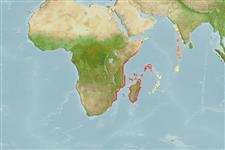Actinopterygii (ray-finned fishes) >
Anguilliformes (Eels and morays) >
Anguillidae (Freshwater eels)
Etymology: Anguilla: Latin, anguilla, .-ae = eel (Ref. 45335).
Environment / Climate / Range
Ecology
Marine; freshwater; brackish; demersal; catadromous (Ref. 51243). Tropical, preferred ?
Africa: Kenya to South Africa (Ref. 3506); Reunion and Mauritius (Ref. 33390). Uncommon south of the Save River. Dominant in the Zambezi system and farther north in East Africa.
Size / Weight / Age
Maturity: Lm ? range ? - ? cm
Max length : 175 cm TL male/unsexed; (Ref. 48660); max. published weight: 20.0 kg (Ref. 3971); max. reported age: 15 years (Ref. 48660)
Dorsal
spines
(total): 0;
Anal
spines: 0. Dorsal fin origin is about midway between pectoral fin and anus. Caudal fin confluent with dorsal and anal fin. Body is mottled with dark brown pigmentation.
Migratory species which breeds in the ocean (Ref. 52331), it requires rivers and oceans (Ref. 30558). Young fish migrate upstream with a continued feeding mode, especially on invertebrates found on rocks and logs washed by fast moving waters (Ref. 30558). They inhabit various niches in a river system (Ref. 13337) and penetrate far inland, surmounting formidable barriers in its upstream migration, including the Kariba and Cahora Bassa dams. Adults need moving water to migrate back to the ocean, especially after heavy rains (Ref. 30558). Their food consists of crabs, frogs and insects (Ref. 30558), and even fish, including trout in the streams of the eastern highlands of Zimbabwe (Ref. 2478). Caught with various types of nets.
Life cycle and mating behavior
Maturity | Reproduction | Spawning | Eggs | Fecundity | Larvae
Skelton, P.H., 1993. A complete guide to the freshwater fishes of southern Africa. Southern Book Publishers. 388 p. (Ref. 7248)
IUCN Red List Status (Ref. 115185)
CITES (Ref. 94142)
Not Evaluated
Threat to humans
Harmless
Human uses
Fisheries: commercial; gamefish: yes
More information
Common namesSynonymsMetabolismPredatorsEcotoxicologyReproductionMaturitySpawningFecundityEggsEgg development
ReferencesAquacultureAquaculture profileStrainsGeneticsAllele frequenciesHeritabilityDiseasesProcessingMass conversion
Tools
Special reports
Download XML
Internet sources
